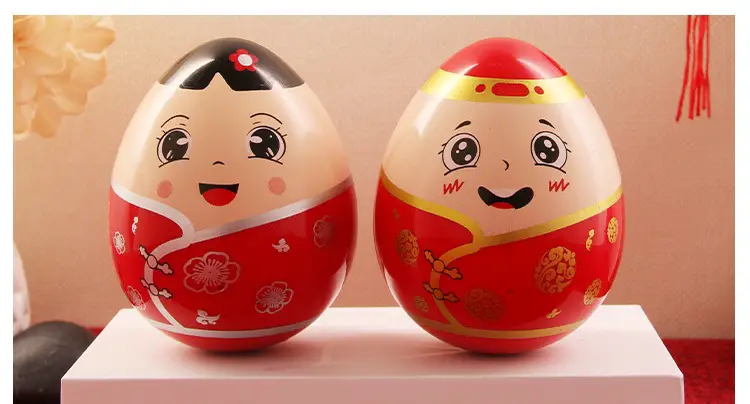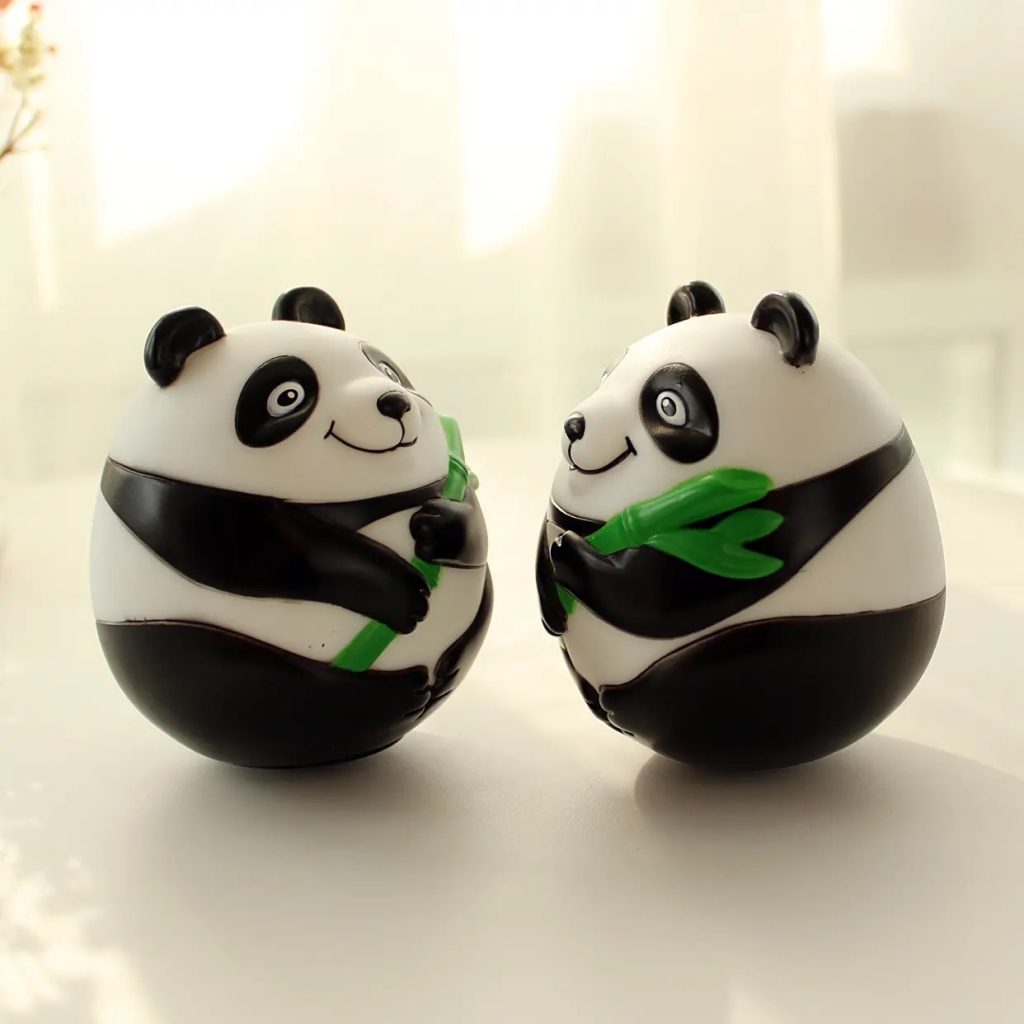The tumbler toy, or “不倒翁” (bù dǎo wēng) in Chinese, is a traditional plaything renowned for its exceptional balance and stability, capable of swaying back and forth without toppling over. Its origins trace back to ancient China, where it stood as a classic among children’s toys. Today, the tumbler toy remains beloved by many and finds utility in various settings, including festival celebrations and performing arts.
roly poly toy history
The history of the tumbler toy can be traced back to ancient China. The earliest documented reference to the tumbler appeared during the Tang Dynasty, known then as “banbudao,” a children’s toy. Over time, it evolved into a form of performing art and was used in various settings, including festive celebrations and acrobatic displays.

During the Song Dynasty, the book “Jiupu Jiuling” by Dou Ge elaborately described the “capturing the drunken immortal” game: “In today’s world, there are many drinking games. There is one called capturing the drunken immortal, which involves turning it using a finger. The target is rewarded with a cup of wine; this is known as the persuasion of the wine immortal.” In the later years of the Tang Dynasty, Lu Wang wrote a piece called “The Long Song of the Wine Immortal,” which mentioned: “The appearance of the immortal resembles a person, transforming in an interesting manner. However, its inclination and instability depend on others, not the wine immortal.”
By the Ming and Qing Dynasties, the craft of making the tumbler further developed. Not only did the materials diversify, but also its forms became more varied. Additionally, the tumbler acquired more cultural significance and symbolic meanings.
In the modern era, the tumbler remains a popular toy and form of performance art. Beyond its entertainment value, it aids in understanding physical principles and the concept of balance. Moreover, the tumbler is utilized in various commercial contexts like advertisements and promotions.
roly poly toy made of
The tumbler toy comprises several main components:
Base: The tumbler’s base typically takes the form of a circular disk, providing support and maintaining balance. It can be made of materials such as plastic, metal, or wood, with the shape and size customizable according to design requirements.
Main Body: This is the primary section of the tumbler, often a hollow or solid sphere. The size and weight of the main body impact the tumbler’s balance and stability.
Center of Gravity Adjustment Device: Positioned within the main body, this device adjusts the tumbler’s center of gravity to alter its movement. Typically, it involves a small lead block or another heavy object whose positioning affects the tumbler’s center of gravity.
Decoration and Appearance: The tumbler’s appearance and decorative elements can be customized based on design specifications, encompassing colors, patterns, materials, etc. These decorative aspects enhance the tumbler’s aesthetics and amusement.
In addition to these primary components, the tumbler may include auxiliary parts like supporting rods, fastening screws, etc., used to stabilize and support the tumbler.
roly poly toy meaning
The tumbler, this ancient and intriguing toy, not only brings endless joy to children but also embodies rich symbolic meanings.

Firstly, the tumbler symbolizes perseverance and the spirit of never giving up. No matter how it tilts, the tumbler always finds its balance point and returns to its original state. Similarly, in life, people facing difficulties and challenges maintain an unwavering spirit, continuously adjusting themselves, ultimately finding balance, and achieving their goals.
Secondly, the tumbler also symbolizes flexibility and the ability to adapt to the environment. Its shape and center of gravity design allow it to maintain balance in different environments. Likewise, people need to possess the ability to be flexible and adaptable to various situations and challenges to thrive in a complex and ever-changing society.
Furthermore, the tumbler symbolizes the cycle and the eternal patterns. No matter how it is shaken, the tumbler restores itself, endlessly repeating its cycle. This reflects many life patterns and phenomena, constantly cycling and repeating. Understanding these patterns and phenomena helps people better grasp the rhythm of life and work.
Lastly, the tumbler symbolizes wisdom and humor. Through clever design and craftsmanship, the tumbler showcases its unique charm and amusement. Similarly, people in life need wisdom and a sense of humor to better deal with various challenges and difficulties, enjoying the pleasures of life.
how does a roly-poly toy work
The principle of a tumbler, an ancient yet intriguing toy, is based on a unique balance characteristic that enables it to remain stable at any angle. This balance phenomenon relies on the physical principles of center of gravity and equilibrium. Here’s a detailed explanation of how a tumbler works:
Shape and Structure of a Tumbler
A tumbler is typically a hollow plastic or rubber toy, often featuring a circular base and a slightly flattened top. Inside the tumbler, there’s a certain amount of weight, usually a lead block or sand, while the exterior consists of lightweight materials like foam or rubber. This structure enables the tumbler to maintain stability when subjected to external forces.
Center of Gravity and Balance
The stability of a tumbler is rooted in the physical principles of center of gravity and balance. The center of gravity refers to the point where the weight’s force acts on an object, while balance denotes an object’s ability to remain stable under external forces. The tumbler’s center of gravity lies at the center of its base, with the pivot point located at the edge of its bottom. When the tumbler is tipped, the center of gravity shifts, always remaining below the pivot point, thereby ensuring balance.
Torque and Moment Arm
Torque is the rotational effect produced by a force applied to an object, and the moment arm represents the distance from where the force acts to the pivot point. When external force impacts a tumbler, it generates torque, seeking to restore the tumbler to a balanced state. Due to the relationship between the tumbler’s center of gravity and pivot point, tipping the tumbler causes the center of gravity to move opposite to the direction of the tilt, producing a torque that restores balance.
Role of Elastic Materials
Tumblers are often made from elastic materials such as rubber or plastic. These materials deform under external forces, absorbing energy and reducing the tumbler’s rocking amplitude. Once the external force ceases, the elastic material returns to its original state, aiding the tumbler in regaining balance. This elasticity allows the tumbler to maintain stability under external influences.
Friction
Friction at the base of the tumbler is also crucial, reducing the impact of external forces. When the tumbler tilts, the friction between the base and the surface prevents sliding, minimizing the extent of rocking. Combining this friction with gravity helps the tumbler maintain stable equilibrium.
In summary, the operation of a tumbler relies on the physics of center of gravity, balance, torque, elastic materials, and friction. These factors work together, enabling the tumbler to resist external disturbances and maintain stable equilibrium. Besides offering entertainment and learning opportunities for children, the design and construction of this toy demonstrate fundamental principles of physics.
In conclusion, the tumbler toy represents an intriguing plaything and form of performing art, showcasing distinctive balance and stability. It offers numerous opportunities for joy and learning.